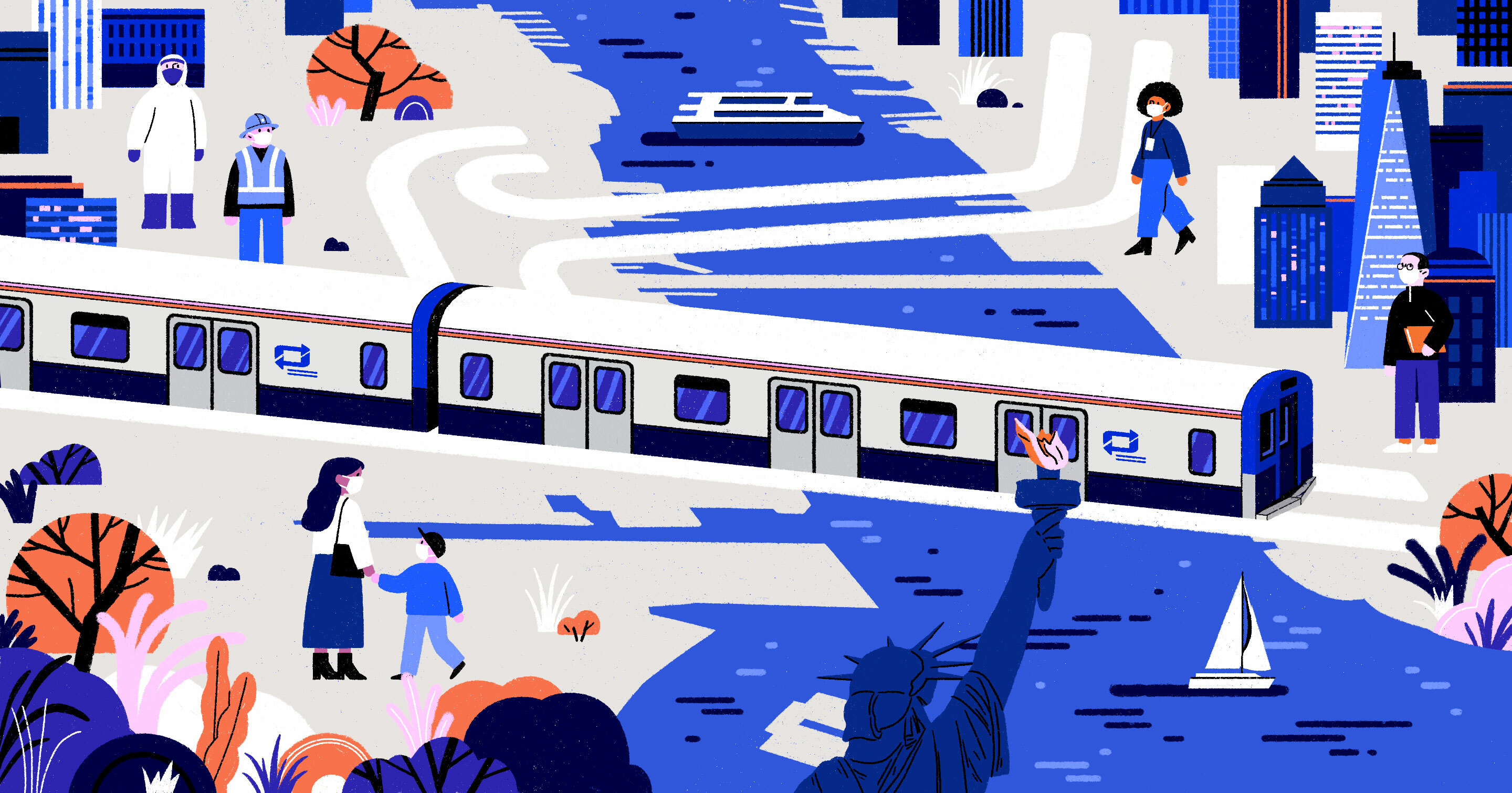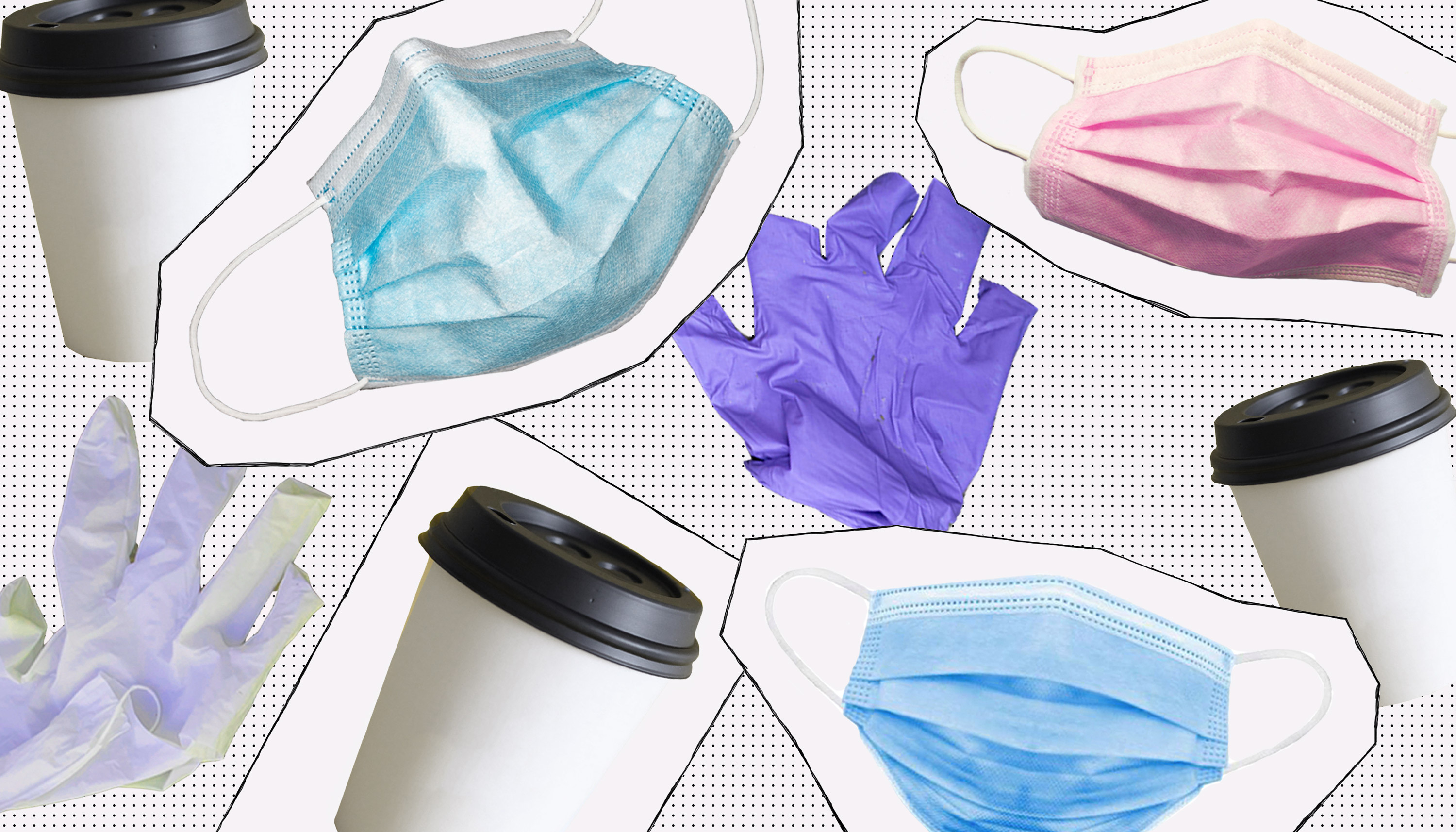Inside the design process to protect people’s health on public transit

In January 2020, news of COVID-19’s approach was building like a looming storm. That the pandemic was coming seemed clear, but when it would arrive, where it would appear, and how bad it would be, nobody could yet predict.
To think back on how we “prepared”—as individuals, organizations, and communities—is a lesson in hindsight. Who could have imagined the new vocabulary, behaviors, and habits we’d all acquire in one short year?
In New York and New Jersey at that time, more than 280,000 people traveled each day on the Port Authority Trans-Hudson (PATH) train, one of the region’s most important public transit systems connecting New Jersey and New York. Squeezed into metal cars, commuters scrolled through headlines suggesting that an unremarkable trip across town might be unwise, if not dangerous. Transit agencies scrambled to establish new guidelines and produce communications to keep riders safe, but the virus was outpacing people’s capacity for behavior change at this scale and speed.
By April, the pandemic had gained a threatening grip on the New York City region, and PATH ridership had fallen off by nearly 95%. Stay-at-home orders took effect, and daily commuters hung up their office attire to the sound of sirens cutting through vacant streets. It wasn’t clear at the time how the disease spread, and how safe mass transit was. All the while, essential workers continued to pass through stations and trains each day, and their lives were on the line.
Transit operators have many contingency plans, but this unforeseen crisis required quick action: at PATH, leaders quickly implemented safety protocols such as overnight train cleaning, and posted signs and messages to let riders know what was being done to protect them, and what new behaviors they'd have to adopt to make sure those protocols actually worked. Everyone’s cooperation was essential, yet not all forms of communication are equally effective.
Try, try again
Inside The Port Authority of New York and New Jersey (PANYNJ), which operates PATH, one small department specializes in thinking about innovation within the institution and—critically—in how riders engage with the system. The Office of Continuous Improvement (OCI) had already been exploring and applying design thinking strategies when they decided to call IDEO to see how a more immersive, design-led approach could yield quick, effective solutions to the challenges COVID had delivered to the PANYNJ systems.
Lisa Dewey-Mattia, who heads the small OCI team, initially connected with IDEO Director Randy Plemel to develop a plan for an immersive, rapid collaboration that might yield some new ideas for communicating with PATH riders and facilitating behavior change. “It was a time when everyone in every industry was trying to figure out, how do we adapt?” Dewey-Mattia recalls, “We had this conundrum with regard to customer confidence and safety, and the physical design of our space. We were asking ourselves, how can we best meet the needs of the agency and our riders right now?” The small team worked remotely to workshop the highest-value, shortest-term problems identified across the whole Port Authority which could fit in a two-week sprint. Plemel remarked, “The OCI team has deep connections across the Port Authority’s different units. Designing for PATH riders and operators allowed us to focus on the most acute issue—confidence in using the system—and the learnings could be transferred to other Port Authority units like the airports and the Port Authority Bus Terminal.”
Large transit agencies aren't typically known for rapid innovation, but the only clear approach to such an unprecedented challenge was a willingness to experiment. When IDEO team members joined OCI and other subject matter experts from across the agency, the product they were working toward was not yet defined. What PATH leaders were looking for was an outcome: all riders wearing their masks properly, maintaining social distance, and heeding public messaging. How to get there wasn’t yet clear. “At that point in time, what we needed was to be able to simplify our communication to our customers. We didn’t need fancy or clever,” says Clarelle DeGraffe, the Director and General Manager of PATH, “But there’s also fear of backlash from customers that it’s too simple.”
With lockdowns and distancing preventing on-the-ground research, the team had to nix in-person interviews and spontaneous conversations, instead establishing remote communication that still yielded candid, comfortable interaction. “This was a very different project for Port Authority,” explains Morgan Keane, DeGraffe’s Chief of Staff. “So much was produced over two weeks’ time, and it was really driven by people being able to collaborate with each other, even remotely.” What became clear was that riders and workers needed to feel confident and safe on the train. Boosting confidence depended on communication strategy.
Over two weeks, IDEO and PATH staff immersed themselves in a design sprint to come up with nine concepts for solving their core challenges, from masking and safety information, to operational changes to the trains, to touchless payments. The large sprint team reviewed these concepts with a panel of advisors at PATH and the greater Port Authority, then pared them down into a series of three prototypes, which hinged on the critical behavioral mandates of COVID: 1.) Stay masked up; 2.) Maintain distance where possible, and; 3.) Practice compliance with stated guidelines.
Live prototyping in a high-stakes environment
PATH and OCI approached Port Authority leadership and asked for permission to use one of the smaller train stations as a place to test ideas. At Grove Street Station in Jersey City, signs went up alerting riders that they’d be seeing some changes around the station, and QR codes on the posters invited real-time feedback as riders passed through. “At every point our customers really understood that we were doing proof of concept,” says DeGraffe, “And that turned out to be positive. Our customers took it as a reassuring indicator that we were looking to pilot new things to keep them safe, and they appreciated us looking outside the box.”
The most successful prototype was a “mask-up zone” at the station entrance, where riders could pause, outside the flow of travelers, to properly cover their faces before descending to the platform. People immediately adjusted their flow through the station to make use of this preparation area. IDEO Senior Design Lead Jeff Kessler, who led the PATH collaboration, points out that the most enduring concepts are the ones that can survive many rounds of doubt. “There’s a balance between protecting new ideas as they emerge and letting them take enough criticism to improve and work. Ultimately, the concepts that survive rounds of testing should improve the long-term operations of the system.”
Down on the platform, a concept designed to keep people apart didn’t prove as effective. Riders provided feedback that they didn’t want to comply with signs directing them where to stand while awaiting the train. Yet, many added, they were reassured to know that new safety measures were under consideration.
That insight led PATH to think beyond posters and signs, to what other means might be used to disseminate their messages. One team member, noting that there’s limited space for signs on trains, was inspired by the “I Voted” stickers people don on their shirts on election day. “Why not be a little cheeky and make stickers to hand out along with free masks? That way passengers themselves become communicators of the message.” The idea was relatively cheap to test out, and it was a sign to riders that the agency was thinking about their well-being.
Although the train is part of many people’s everyday lives, DeGraffe says it still comes as a surprise to some that train operators and leadership are truly listening to what they have to say about their experience. “Everyone thinks of it as their own little train,” says DeGraffe of PATH’s rider culture. “They post things to Twitter about their experience and we respond.” That personal, human outreach has the benefit of building trust and connection between riders and their transit system—a better way to foster adherence than by cracking down on non-compliant individuals. DeGraffe points to the increased tension around police interaction during this time. “We’d rather give out a mask than a summons.”

Lessons for the future
More than a year after COVID first rolled into New York and New Jersey, ridership on public transit hasn’t returned to pre-pandemic levels, but residents are slowly resuming routines and vaccination rates are raising a little hope into a shaken city. At PATH, the spirit of exploration and willingness to prototype have remained. In late January 2021, PATH announced a new diplomatic corps called the Mask Force Ambassadors, “a group of volunteers whose daily mission is to help keep riders masked, socially distant, and able to travel in the safest possible environment.” On those volunteers’ bright yellow t-shirts and in large lettering around the stations, riders see the simple message developed during the IDEO sprint: “Mask On. Ride On.”
PATH Chief of Staff Keane reflects on how similar adaptive responses have appeared in other areas of the city, and where she sees the impact of institutions that are slow to change and accommodate their communities. “During COVID, the streets are being taken over for outdoor eating, distanced interaction, bookstores with takeout windows. It’s interesting to think about new ways to do things,” says Keane, “And it’s important to test for the extremes: Say okay, can a really old person do this and a child do this? Can you get from an underground station to an outdoor plaza while pushing a stroller? The way to really bring this home for people is to have them walk through with a different perspective.”
That constructive empathy is exactly what Kessler hoped for from the PATH and IDEO collaboration. “This was a moment when if we got the nuances right it would keep people healthy and taking care of each other and giving each other respectful space on the train,” he says, noting how bravely PATH stepped into experimentation as a new route to safety. “It’s a good thing for design to be working on.”
Illustrations by Ran Zheng
Words and art

Subscribe

.svg)









